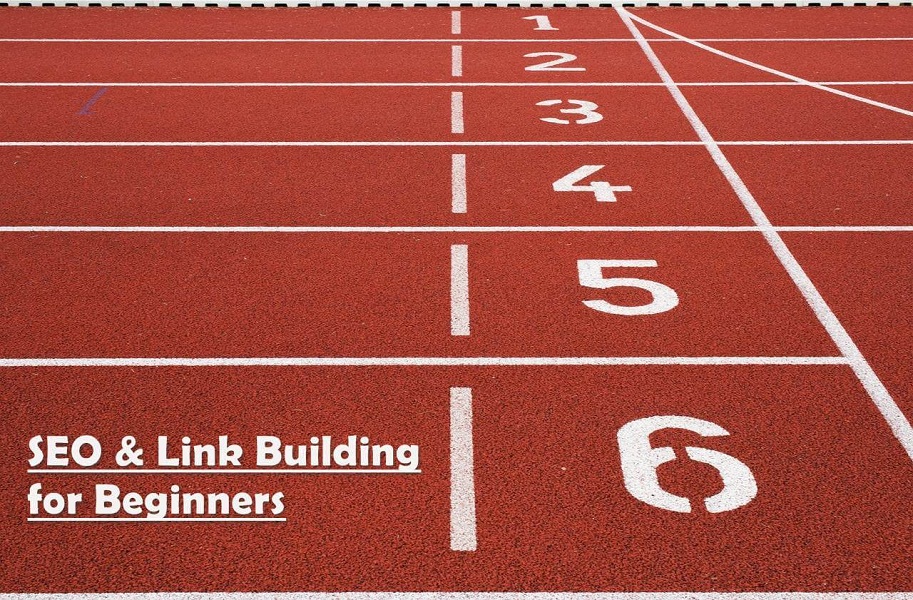Defining SEO and Link Building
SEO is the practice of improving and optimizing a website so that it ranks higher in search engine results. It encompasses a variety of tactics and strategies, including keyword research, content optimization, technical improvements, and user experience enhancements. The objective is to improve a site’s visibility for relevant searches, thereby increasing the quantity and quality of organic traffic.
Link building is a subset of SEO that focuses on acquiring backlinks from other websites. A backlink is a hyperlink from another website pointing to your site. The search engines consider these backlinks as ‘votes’ of credibility and authority, thereby positively influencing your site’s ranking. It is not just about the quantity of links but also their quality—links from trustworthy, authoritative sites are more impactful.
The Power of Organic Search
Why Organic Search Matters
In the realm of online search, ‘organic’ refers to the natural listings that appear in search results, as opposed to paid advertisements. Organic search is crucial for several reasons:
- Trustworthiness: Users often consider organic results to be more credible than paid ads. This leads to a higher click-through rate (CTR) and potentially more conversions.
- Cost-Effectiveness: While achieving high organic rankings does involve an investment in SEO, it is generally more cost-effective in the long run compared to paid search.
- Long-Term Results: Once your website ranks well organically, it can maintain that position over an extended period, assuming ongoing SEO efforts and quality content.
How SEO and Link Building Intertwine
The Symbiotic Relationship
SEO is not a one-dimensional endeavor; it involves multiple factors, both on-page and off-page. Link building is an essential aspect of off-page SEO. Here’s how they work together:
- Authority and Relevance: Quality backlinks from reputable sites signal to search engines that your website is an authoritative and relevant resource in your industry, thus positively affecting your overall SEO.
- Referral Traffic: Good backlinks not only improve your SERP rankings but also bring in relevant traffic from other websites, adding another source of organic traffic.
- Network Building: The process of acquiring backlinks often involves outreach and collaboration, which can lead to beneficial relationships within your industry.
The Evolution of SEO over Time
A Brief History
- Keyword Stuffing Era: In the early days, SEO was as simple as using keywords as much as possible. But this led to poor user experience.
- Link Farming Period: There was also a time when acquiring mass links from so-called ‘link farms’ could boost your rankings. Google’s algorithm updates like Panda and Penguin put an end to these practices.
- Modern-Day SEO: Nowadays, SEO is much more sophisticated, involving a user-centric approach, mobile-friendliness, and a focus on providing genuine value. Topics, not just keywords, have become crucial, and quality backlinks are more important than ever.
Understanding the evolving nature of SEO is crucial for staying competitive. It’s not a ‘set it and forget it’ tactic but requires constant adaptation to search engine algorithms and user behavior.
By deeply understanding and implementing these components of SEO and link building, businesses can create a sustainable and effective digital marketing strategy.
Connect with our top-notch SEO experts and start your journey to digital success. Contact us today.
The Art of On-page SEO
On-page SEO, sometimes referred to as “on-site SEO”, involves optimizing the elements within a website to improve its position in search engine rankings. Unlike off-page SEO which concerns itself with backlinks and external signals, on-page SEO focuses on enhancing the website itself. From the content to the underlying HTML source code, it’s all about making your site as search-friendly as possible.
Meta Tags and Their Relevance
What are Meta Tags?
Meta tags are snippets of text that describe a page’s content. They don’t appear on the page itself but in the page’s HTML code. Search engines use these tags to understand what a page is about and to display snippets in search results.
Types of Important Meta Tags
- Title Tag: This is arguably the most critical meta tag. It defines the title of a webpage, which appears on search engine results pages (SERPs) and the browser’s tab.
- Meta Description: This tag gives a brief summary of a webpage’s content. It’s the text that appears beneath the title in SERPs.
- Meta Keywords: Once important, this tag is now largely ignored by search engines due to over-optimization and keyword stuffing.
- Robots Meta Tag: This tag instructs search engines on how to index a page. It can tell search engines not to index a page or not to follow the links on a page.
Relevance: Properly optimizing meta tags ensures that search engines understand the content of your pages. This can improve click-through rates from SERPs as users get a quick snapshot of what your page is about.
Importance of High-Quality, Relevant Content
Quality over Quantity
It’s no longer enough to produce content in large volumes; it needs to be high-quality, informative, and relevant to the target audience. Google’s algorithms, particularly the BERT update, are designed to understand the context and intent behind user queries.
Benefits of Quality Content:
- Better Engagement: Engaging content keeps users on your site longer, decreasing the bounce rate.
- Builds Trust: Informative and accurate content establishes authority and trust with the audience.
- Improved Rankings: Search engines prioritize high-quality, relevant content in SERPs.
Image Optimization for SEO
Why Optimize Images?
Optimizing images can improve page load speed, enhance user experience, and provide additional ranking opportunities.
Optimization Techniques:
- File Size: Compressing images without losing quality can drastically improve page load times.
- Alt Text: This describes the content of the image, helping search engines understand the context. It’s also vital for accessibility.
- File Name: Naming image files descriptively can further help search engines understand its content.
- Responsive Images: Serving different image sizes for different devices ensures faster load times on mobile devices.
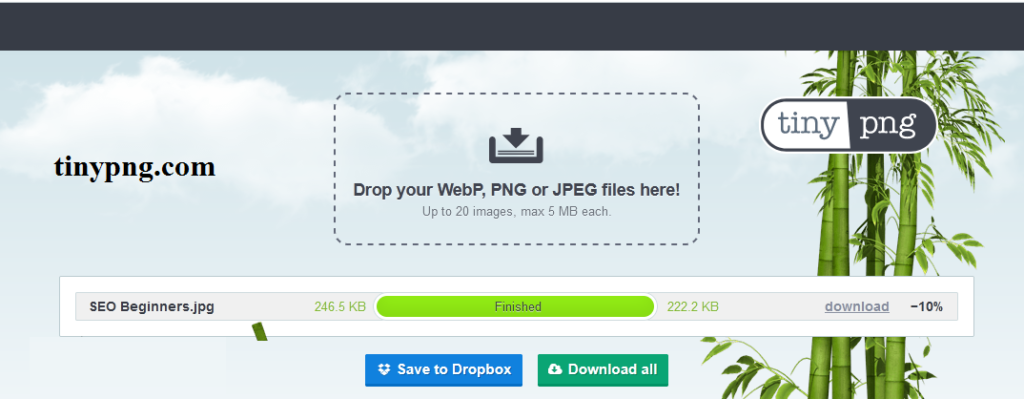
Mobile Responsiveness and SEO
The Rise of Mobile
With more than half of global internet users accessing the web via mobile devices, mobile responsiveness is no longer optional.
SEO Implications:
- Mobile-First Indexing: Google predominantly uses the mobile version of the content for indexing and ranking. This makes it essential for a site to be mobile-friendly.
- User Experience: A mobile-responsive site ensures a better user experience, reducing bounce rates and increasing time on site.
- Increased Traffic: As mobile usage continues to rise, having a mobile-friendly site can lead to more traffic and potential conversions.
In conclusion, on-page SEO is an art that involves myriad components. Each aspect, whether it’s meta tags, content, images, or mobile responsiveness, plays a crucial role in improving a website’s visibility, usability, and ranking in search engines.
Demystifying Technical SEO
Technical SEO involves optimizing the foundation and infrastructure of a website. Unlike on-page SEO, which focuses on content and user experience, technical SEO ensures that search engines can crawl, interpret, and index the content of a website. Though it might seem complex at first glance, understanding the core components can pave the way for better site performance and improved rankings.
Importance of Website Speed
Why Speed Matters
- User Experience: Slow-loading websites can deter users, leading to high bounce rates. A speedy website provides a better user experience, encouraging visitors to stay longer and interact more with the content.
- Ranking Factor: Google has officially acknowledged site speed as a ranking factor, meaning faster websites are likely to rank higher in SERPs.
Optimizing for Speed
- Minimize HTTP Requests: By streamlining the number of elements (like scripts, images, and CSS files) loaded on a page, you can boost its speed.
- Optimize Images: Compressing images without sacrificing quality can drastically reduce page load times.
- Leverage Browser Caching: By storing parts of your website in a user’s browser cache, you can reduce load times for subsequent visits.
Structured Data and Schema Markup
Structured Data: It’s a standardized format to provide information about a page and classify its content. This can assist search engines in understanding a webpage’s content and context.
Schema Markup: A vocabulary of tags (or microdata) that can be added to your HTML to improve the way search engines read and represent your page in SERPs.
Benefits:
- Rich Snippets: By using structured data, you can enhance the appearance of your listing in SERPs, including reviews, ratings, and images.
- Improved CTR: Enhanced listings often result in a higher click-through rate.
- Voice Search Optimization: Structured data can make your content more accessible for voice search results.
XML Sitemaps and Robots.txt
XML Sitemaps: An XML sitemap lists a website’s important pages, aiding search engines in understanding the site’s structure. It’s especially crucial for sites with deep navigation or fresh content.
Robots.txt: It’s a file placed in the root directory of a website that instructs search engines on which pages or sections of the site should not be indexed.
Benefits:
- Improved Crawling: With an XML sitemap, search engines can better crawl and understand the hierarchy and importance of content.
- Control Over Indexing: Robots.txt allows webmasters to prevent certain sections or pages from being indexed, ensuring that only relevant content is shown in search results.
Ensuring a Secure and Accessible Website
SSL (Secure Socket Layer): Websites with SSL (indicated by HTTPS in the URL) are encrypted, ensuring data security for its users. Google has acknowledged HTTPS as a ranking factor.
Website Accessibility: It’s essential to ensure that websites are accessible to all users, including those with disabilities. Proper tagging, site structure, and alt text for images are some aspects of accessibility.
Benefits:
- User Trust: An HTTPS website promotes trust as users know their data is secure.
- Better Rankings: Secure and accessible websites often see a ranking boost in SERPs.
- Broader Audience Reach: Ensuring your website is accessible makes it usable for a more diverse user base, including those with impairments.
In conclusion, technical SEO might seem daunting, but it forms the backbone of any successful SEO strategy. By understanding and implementing its components, businesses can create a solid foundation for both search engines and users.
Mastering Off-page SEO and Link Building
While on-page and technical SEO focus on optimizing the content and infrastructure of your website, off-page SEO looks beyond the confines of your domain. Primarily centered around link building, off-page SEO is all about enhancing your site’s authority, trustworthiness, and relevance. Let’s delve deep into understanding the nuances of backlinks, link types, and effective methods to secure high-quality links.
The Concept of Backlinks
What are Backlinks?
Backlinks, often simply referred to as “links,” are external hyperlinks from other websites pointing to your site. Think of them as votes of confidence or endorsements from other sites.
Why are they Important?
- Search Engine Rankings: Search engines like Google use backlinks as a significant factor in their ranking algorithms. A high number of quality backlinks can improve your website’s SERP ranking.
- Referral Traffic: Apart from SEO benefits, backlinks also direct users from other websites to yours, leading to increased traffic.
- Authority and Trust: Links from authoritative sites can enhance the perceived trustworthiness and credibility of your website.
Differentiating Between Do-Follow and No-Follow Links
Do-Follow Links:
- Nature: By default, all backlinks are do-follow. This means they pass “link juice” or SEO value to the linked website.
- Use: When another website wishes to endorse or credit your content, they might give you a do-follow link.
No-Follow Links:
- Nature: Introduced to combat spammy link practices, a no-follow link does not pass SEO value. It’s essentially a way to link to another site without endorsing it.
- Use: Often used in comment sections, forums, or any place where there’s a high risk of spammy links. Also, used for paid links as per Google’s guidelines.
Relevance:
While do-follow links are traditionally seen as more valuable due to their SEO benefits, no-follow links can still bring valuable referral traffic and diversify your link profile.
Methods of Acquiring Quality Backlinks
Natural Editorial Links: These are the gold standard of backlinks. They are given by other websites without any action on your part, other than creating great content.
Manual Outreach: By reaching out to bloggers or webmasters and asking them to link to your content.
Self-Created Links: Through blog comments, forum signatures, or directories. These tend to be of lower value and, if overused, can be seen as spammy.
High-Quality Directories and Guest Posts: By submitting your site to trusted directories or writing guest posts for reputable sites in your niche.
Guest Blogging and Link Building
Guest Blogging: This involves writing articles or posts for other websites in your niche. In return, you usually get a link back to your website, either within the content or in an author bio.
Benefits:
- Reach a Wider Audience: Guest posting allows you to tap into the existing audience of another website, increasing your visibility.
- Establish Authority: Writing insightful posts on other platforms can establish you as an authority in your field.
- Quality Backlinks: Guest blogging on reputable sites provides high-quality, contextual backlinks.
Caveats:
Ensure you’re guest blogging for the right reasons. Aim for sites relevant to your niche and avoid low-quality sites that exist solely for SEO link building.
In summary, mastering off-page SEO and link building requires strategic effort, genuine outreach, and consistent content of high quality. The benefits, in terms of increased visibility, authority, and traffic, can be substantial when done correctly.
Essential Link Building Techniques
Link building remains a cornerstone of SEO strategy. While the landscape of SEO evolves, the importance of securing high-quality backlinks cannot be understated. This process, when done ethically, can significantly elevate a site’s authority, drive referral traffic, and boost organic rankings. Let’s dive into some essential techniques and strategies to effectively build those coveted links.
Skyscraper Technique Explained
Definition: The Skyscraper Technique, coined by Brian Dean of Backlinko, is a method where you find existing popular content within your niche, create an even better version of it, and then reach out to those who’ve linked to the original content to link to yours instead.
Steps:
- Research: Identify a piece of content (or several) in your niche that is already popular and has garnered a significant number of backlinks.
- Improve: Create a piece of content that surpasses the original in quality. This could mean making it more comprehensive, updating outdated information, enhancing the design, or adding multimedia elements.
- Promotion: Reach out to all the people who linked to the original content. Present your piece as an updated, more thorough version and request a link.
Benefits: When executed correctly, the Skyscraper Technique can result in a rapid influx of high-quality backlinks.
Broken Link Building Strategy
Concept: Broken link building involves finding dead or broken links on other websites, creating content that matches or improves upon the original content, and then suggesting to the website owner that they replace the broken link with a link to your new and improved content.
Steps:
- Identify Broken Links: Using tools like Ahrefs or Screaming Frog, find broken links related to your niche on other websites.
- Create Valuable Content: Once you’ve identified a broken link, examine the original content it pointed to (using the Wayback Machine) and create a superior version of it.
- Outreach: Contact the website owner, inform them about the broken link, and pitch your content as a replacement.
Benefits: Besides acquiring a backlink, you’re helping website owners fix issues on their site, making this strategy a win-win.
Using Outreach for Link Building
Concept: Outreach is a proactive method to secure backlinks. It involves contacting bloggers, journalists, or website owners and pitching your content for a link or a mention.
Steps:
- Identify Targets: Find sites or individuals who might be interested in your content. This could be because they’ve linked to similar content before or because your content fills a gap in their existing resources.
- Craft a Compelling Pitch: When reaching out, be concise, and explain why your content adds value to their audience. Personalization is key.
- Follow-up: If you don’t receive a response, a gentle follow-up can be effective. However, always respect their decision if they’re not interested.
Benefits: Outreach can help in building relationships within your industry, potentially leading to numerous backlink opportunities.
The Role of Social Media in Link Acquisition
Concept: Though social media links are typically no-follow (meaning they don’t pass direct SEO value), they play an indirect role in link building. Sharing content on social platforms can increase its visibility, which in turn can lead to more organic backlinks from other sites.
Strategies:
- Shareable Content: Create content that is easily shareable on social platforms, like infographics or videos.
- Engage with Your Audience: Foster a community on social platforms. Engaging content can result in shares, increasing the chance that someone sees and links to your content.
- Leverage Influencers: Collaborating with social media influencers can help amplify your content reach.
Benefits: Increased visibility from social shares can attract natural backlinks, boost brand awareness, and drive traffic.
In conclusion, effective link building is an amalgamation of creativity, persistence, and understanding of SEO intricacies. While it’s a long-term effort, the potential payoff in terms of site authority and organic ranking growth is significant.
Avoiding Link Building Pitfalls
Link building, while a powerful SEO strategy, is fraught with potential pitfalls. As search engines, especially Google, become smarter at identifying manipulative tactics, it’s imperative to approach link building ethically and strategically. This section will help you identify what not to do and how to safeguard your website from potential penalties.
The Danger of Black Hat Techniques
What are Black Hat Techniques?
Black Hat SEO refers to aggressive SEO strategies that violate search engine guidelines and best practices. They might provide short-term gains, but often result in long-term pain, including penalties.
Common Black Hat Link Building Techniques:
- Link Spamming: Indiscriminately posting your link on forums, comment sections, and other platforms.
- Hidden Links: Using white text on a white background, or placing a link behind an image.
- Link Wheels: Creating a circle of sites that link to each other to boost perceived authority.
Why Avoid Them?
- Search Engine Penalties: Using black hat techniques can get your website penalized or even de-indexed.
- Reputation Damage: Your website’s credibility can suffer, driving away potential visitors or customers.
Understanding Google Penalties
What are Google Penalties?
A Google penalty is a punitive action taken against a website that’s found to be in violation of Google’s guidelines.
Types of Penalties:
- Manual Penalties: A human reviewer from Google determines that a site is violating the guidelines.
- Algorithmic Penalties: Automatic penalties applied by Google’s algorithms (like Penguin for link schemes).
How to Recover:
- Diagnose the Issue: Using Google Search Console, identify messages or traffic drops that indicate a penalty.
- Rectify the Violation: Remove or disavow spammy backlinks, update or delete poor-quality content, etc.
- Submit a Reconsideration Request: Once the issue is fixed, ask Google to review your website again.
Ensuring a Natural Link Profile
What is a Natural Link Profile?
It’s a link profile that appears organic, with backlinks coming from various sources, using diverse anchor text, and built over time, rather than suddenly.
Tips to Maintain a Natural Profile:
- Diverse Anchor Text: Instead of using the same keyword-focused anchor text for every backlink, have a mix of branded, generic, and varied keyword anchor texts.
- Varied Link Sources: Get backlinks from different types of sites – blogs, news sites, forums, etc.
- Steady Link Velocity: Acquire links at a steady, organic pace rather than in sudden spikes.
Staying Away from Link Farms and Purchased Links
What are Link Farms?
Link farms are groups of websites that interlink with each other to inflate perceived site authority.
Purchased Links:
Buying backlinks is against Google’s guidelines. While it might seem like a quick way to gain backlinks, it can lead to penalties.
Why Avoid Them?
- Short-lived Success: While these techniques might give a temporary boost, they don’t offer long-term value.
- Penalty Risk: Google can identify and penalize sites involved in such schemes.
- Reputation: Associating with link farms can damage your website’s reputation among users and within the industry.
In essence, while the allure of quick gains through questionable link-building methods can be tempting, the risks far outweigh the benefits. Adopting white-hat techniques, staying updated with search engine guidelines, and focusing on creating genuine value will result in sustainable, long-term SEO success.
Tools & Platforms for SEO and Link Building
In the digital age, mastering SEO and link-building isn’t just about strategies and tactics—it’s also about leveraging the right tools and platforms. From monitoring your site’s performance to spying on your competitors’ backlink profiles, several tools can make the process more efficient and data-driven. Here’s a closer look at some industry-favorites:
Google Search Console and its Features
What is Google Search Console (GSC)?
GSC is a free service offered by Google that helps website owners monitor, maintain, and troubleshoot their site’s presence in Google Search results.
Key Features:
- Performance Reports: Analyze click-through rates, impressions, and the average position for various queries.
- Index Coverage: Track which pages on your site have been indexed, and fix potential errors preventing indexing.
- Mobile Usability: Understand how mobile-friendly your site is, with insights into potential issues.
- Link Report: View which sites link to your website and which internal pages they’re linking to.
- Manual Actions: If Google finds that you’re violating guidelines, this section will show those issues.
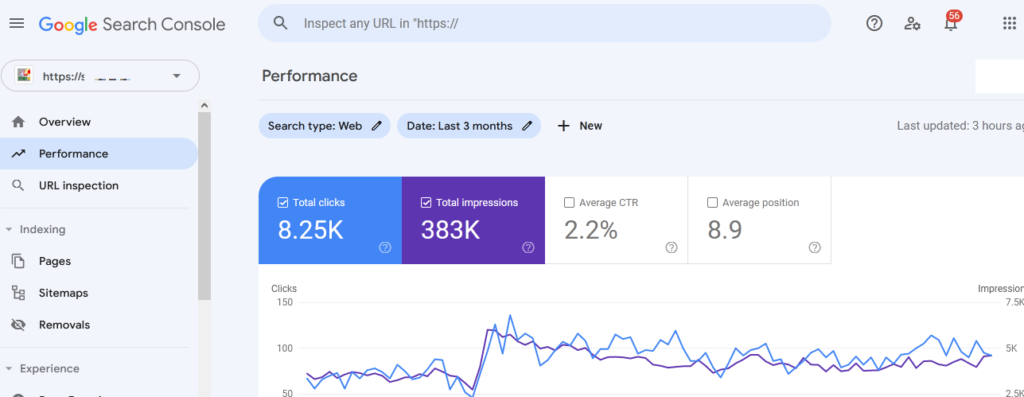
Exploring Ahrefs, SEMRush, and Moz
Ahrefs:
- Key Features: Backlink analysis, keyword research, site audit, content explorer, and rank tracker.
- Unique Selling Point: A robust backlink database and a straightforward user interface.
SEMRush:
- Key Features: Domain analytics, keyword research, site audit, rank tracking, and a content marketing toolkit.
- Unique Selling Point: Broad toolset covering both SEO and paid advertising, including competitive analysis.
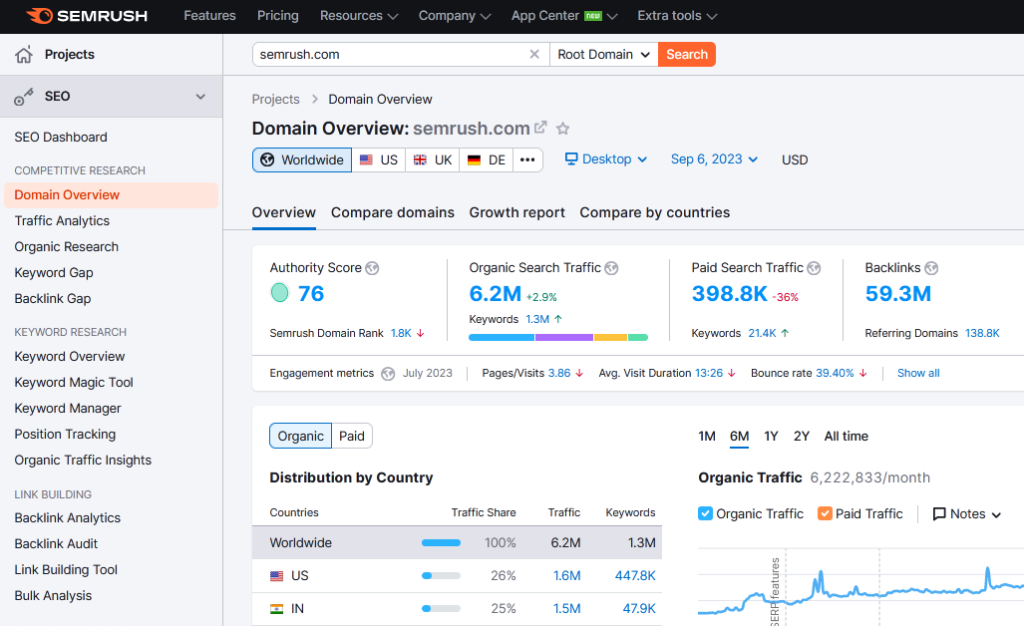
Moz:
- Key Features: Link analysis, keyword research, rank tracking, and on-page optimization insights.
- Unique Selling Point: The MozBar, an SEO toolbar for Chrome, and the Domain Authority (DA) metric, which gauges site authority.
All three are powerful SEO platforms, with varying strengths. Your choice may depend on specific needs, budget, and personal preference.
Using BuzzSumo for Content and Link Analysis
What is BuzzSumo?
BuzzSumo is a tool designed to discover, analyze, and monitor content. It’s invaluable for content marketers and link builders alike.
Key Features:
- Content Discovery: Find the most shared and trending content in any niche.
- Content Alerts: Receive alerts for brand mentions or specific keywords.
- Backlink Checker: Identify who links to your content or your competitors’ content.
- Influencer Identification: Find and connect with top influencers in any sector.
Unique Selling Point: Offers a holistic view of content performance, from shares to backlinks, and helps identify content opportunities.
The Power of Yoast for On-page SEO
What is Yoast?
Yoast is a popular WordPress plugin designed to help site owners optimize their content for search engines.
Key Features:
- Meta Tags: Easily modify meta titles and descriptions for your posts.
- Readability Analysis: Offers suggestions to improve the legibility of your content.
- Breadcrumbs: Helps set up and modify navigational breadcrumbs.
- Internal Linking: Provides suggestions for internal links based on your content.
- XML Sitemaps: Auto-generates sitemaps for better indexing by search engines.
Unique Selling Point: Integrates seamlessly with WordPress, providing real-time feedback on SEO and readability as you write or edit content.
Incorporating these tools into your SEO and link-building workflow can streamline processes, provide deeper insights, and ensure that you’re making data-driven decisions. Whether you’re an SEO newbie or a seasoned pro, these platforms offer invaluable data and functionalities to help boost your digital presence.
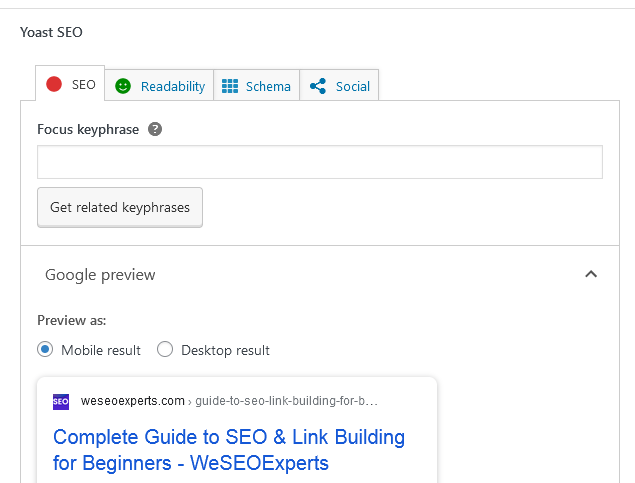
Monitoring, Analytics, and Reporting
SEO is not a one-time endeavor. It’s an ongoing process of monitoring, analyzing, and refining. Constant vigilance ensures that a website remains compliant with search engine guidelines and continues to rank well. This section delves into the nuances of tracking performance, key metrics, reporting ROI, and the significance of regular audits.
Tracking SEO Performance
Why is Tracking Essential?
- Identify Strengths and Weaknesses: Knowing how your SEO strategies are performing can help determine what’s working and what’s not.
- Competitive Analysis: Understand where you stand compared to competitors.
- Informed Decision Making: Data-driven decisions tend to be more effective and efficient.
Tools for Tracking:
- Google Analytics: A comprehensive tool to monitor website traffic, user behavior, and more.
- Google Search Console: Provides insights into how Google views and indexes your website.
- SEMRush, Ahrefs, Moz: These platforms offer additional tracking capabilities, especially for backlink profiles and keyword rankings.
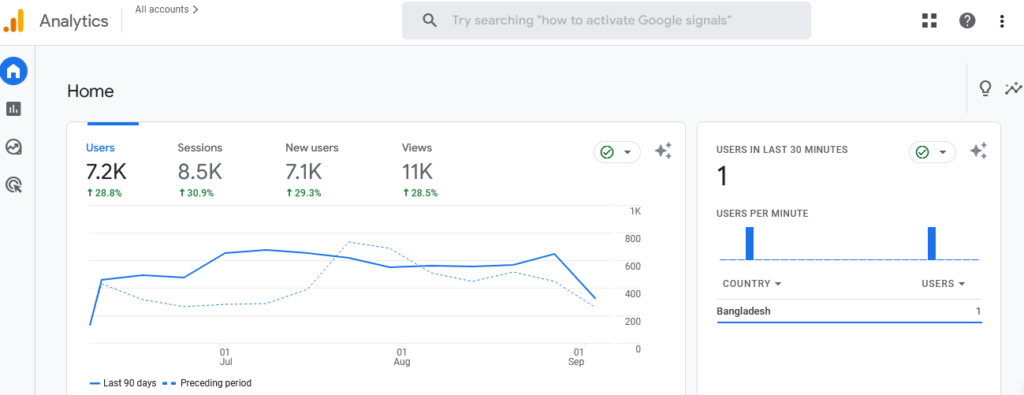
Metrics that Matter in SEO
- Organic Traffic: The number of visitors coming to your site via search engines.
- Keyword Rankings: Where your website stands in search engine results for specific keywords.
- Click-Through Rate (CTR): The percentage of people clicking on your link after seeing it in search results.
- Bounce Rate: The percentage of visitors who leave your site without interacting further.
- Page Load Time: How long it takes for your web page to load; a critical factor for both SEO and user experience.
- Backlink Profile: The number and quality of other websites linking to yours.
- Domain and Page Authority: Metrics developed by Moz that predict how well a website will rank on search engine result pages.
Reporting ROI from SEO Efforts
ROI, or Return on Investment, measures the profitability of an investment relative to its cost. In SEO, it’s vital to demonstrate the value derived from SEO activities.
How to Report ROI:
- Set Clear Goals: Whether it’s increased organic traffic, higher conversions, or more sales, know what you’re aiming for.
- Track Conversions: Use tools like Google Analytics to monitor actions like form submissions, downloads, and purchases.
- Assign Monetary Value: If possible, determine the average value of a conversion (e.g., the average sale value).
- Calculate Costs: Include expenses like tools, content creation, and any other SEO-related costs.
- Determine ROI: Use the formula: [(Net Profit – Cost of SEO) / Cost of SEO] * 100%.
Ongoing SEO Audits and Improvements
What is an SEO Audit?
An SEO audit is a comprehensive examination of a website to determine its ability to appear in search engine results pages (SERPs).
Why Regular Audits?
- Algorithm Updates: Search engines, especially Google, frequently update their algorithms. Regular audits ensure your website remains compliant.
- Competitive Landscape: Your competitors aren’t static. They’re continually optimizing, and so should you.
- Technical Health: Over time, technical issues can crop up, like broken links or slow load times, which can hurt SEO.
- Content Relevance: Ensure that your content remains up-to-date and relevant to your audience’s needs.
Audit Areas:
- Technical SEO: Site speed, mobile-friendliness, sitemaps, and crawl errors.
- On-Page SEO: Content quality, keyword optimization, meta tags, and internal linking.
- Off-Page SEO: Backlink profile analysis and domain authority checks.
- User Experience: Navigation, site structure, and overall user-friendliness.
In essence, SEO isn’t just about getting to the top of search results but staying there. It requires a continuous commitment to monitoring, analytics, and refinement. Regularly assessing key metrics and making necessary adjustments ensures that your website remains visible, relevant, and effective in achieving its goals.
Future of SEO & Link Building
As the digital landscape evolves, so does the world of SEO and link building. Trends that were once on the periphery have become central, and innovations continue to redefine how we approach online visibility. Let’s delve into some of the game-changing trends that are shaping the future of SEO.
Voice Search and SEO
Understanding Voice Search:
Voice search allows users to verbally ask questions or command digital devices, rather than typing queries. With the proliferation of voice-activated assistants like Alexa, Siri, and Google Assistant, voice search has surged in popularity.
Implications for SEO:
- Natural Language: Voice searches are often more conversational. Websites need to optimize for long-tail keywords and complete sentences.
- Local SEO Boost: Many voice searches are location-based. “Near me” searches are more frequent, emphasizing the importance of local SEO.
- Fast Load Times: Voice search devices prioritize faster-loading websites.
- Featured Snippets: These are often the source for voice search answers. Striving for the featured snippet spot can be beneficial.
Role of Artificial Intelligence in SEO
AI in SEO:
Search engines are increasingly using artificial intelligence to improve search results. Google’s RankBrain, for instance, is an AI component of its core algorithm.
How AI Impacts SEO:
- User Experience: AI can analyze user behavior to determine the relevance and quality of content.
- Content Creation and Optimization: AI tools can now suggest content improvements, making it more SEO-friendly.
- Personalization: AI can adjust SERPs based on user behavior, device, location, etc.
- Automated Tasks: AI can handle repetitive tasks, such as meta tag creation or even basic content creation, more efficiently.

The Increasing Importance of Video SEO
Why Video?
Video content is dominating the internet. Platforms like YouTube have massive user bases, and videos are increasingly appearing in standard search results.
Video SEO Tactics:
- Transcriptions: Search engines can’t “watch” videos, but they can index text. Transcribing videos can make them more searchable.
- Optimized Video Titles and Descriptions: Just as with written content, appropriate keyword placement is crucial.
- Video Thumbnails: An engaging thumbnail can significantly increase click-through rates.
- Engagement Metrics: Comments, shares, likes, and view duration can influence video ranking.
Mobile-first Indexing and Its Implications
What is Mobile-first Indexing?
Google primarily uses the mobile version of content for indexing and ranking. As most users now access Google via a mobile device, this makes sense.
SEO Implications:
- Mobile Optimization: Websites that aren’t mobile-friendly will suffer in rankings. Responsive design is crucial.
- Speed: Mobile users expect fast load times. Google also prioritizes faster websites in its rankings.
- User Experience: Mobile sites should be easy to navigate, with clickable elements spaced out and readable text.
In conclusion, the future of SEO is not static. It’s dynamic, driven by technological advancements and changing user behaviors. Adapting to these changes will ensure that your SEO strategies remain effective and that your online presence remains strong.

Meet Yahia Khan, an internationally recognized, award-winning SEO expert with a proven track record of driving success. He’s the maestro you’ve been searching for to elevate your brand’s online visibility.
Learn more about Yahia Khan here
From comprehensive SEO strategies to effective link building services, we offer it all. Take your online marketing to the next level by choosing to work with Yahia Khan and the team at We SEO Experts.
